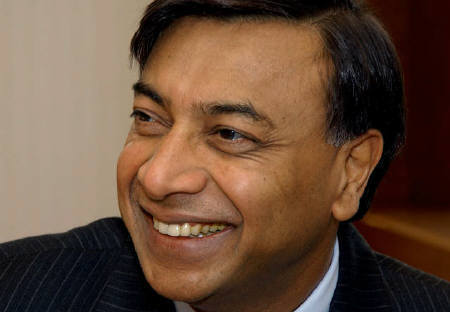Lakshmi Naravan Mittal (also known as Lakshmi Niwas Mittal) was born in the remote village of Safalpur in the desert state of Rajasthan. The village that Mittal grew up in had no electricity or basic amenities. In an attempt to better his family's living standards, his father moved the family to Calcutta in the early I960s. There Lakshmi Mittal's father bought over a small steel factory in Calcutta. Mittal studied business and accountancy at St. Xavier's College, from 6.30 am to 9.30 am before returning to work a full day in the family business.
These years created an indelible mark in young Mittal's mind, and began to fuel his passion to achieve something big in his life. In 1976, Mittal completed his graduation in Commercial Studies. Along with his father, Lakshmi Mittal started a company called “Ispat” to manufacture steel. He was well ingrained in the Steel business within a few years, but he was not satisfied with the prospect of running a small business. There was a fierce ambition in Mittal, which drove him to achieve greater heights.
At that point in time, the Indian Government passed a rule restricting domestic steel production. Mittal looked for options abroad. He started a state-of-the-art mill in Indonesia. This was the turning point in Mittal's career, as he eventually found his opportunity in the international marketplace. The international demand for steel was tremendous as the world was going through a massive economic growth. His factory needed non-scrap iron to meet this demand. This took Mittal to Trinidad and Tobago, where he was able to source the same.
In 1989, Mittal found an opportunity in Trinidad, where he bought a steel firm called Iscott. The firm had a good infrastructure but bad management, because of which it was making heavy losses. Mittal saw the challenge laden with opportunity, and plunged into the resurrection of the firm. Within a year, under Mittal's sound management, Iscott was making profits. This strategy has remained Mittal's forte till this day. He purchased many more loss-making steel factories, and turned them around with his prowess and professional management. Lakshmi Mittal had arrived.
The world of steel had sensed the entry of a magnate, and the stage was set for a spate of takeovers and growth. Over the next decade, Mittal moved on successfully through various acquisitions in many countries. He bought Steel Plants in Mexico, Canada, Germany, Ireland and Kazakhstan. All of these added to his already vast wealth. Lakshmi Mittal wanted to shift his headquarters to London, UK, which he saw as the world’s financial epi-centre. He quickly moved his operations from Indonesia to London in 1995. This move helped the group's growth in revenues tremendously.
Over the next 5 years, Mittal's list of companies grew, and so did his personal wealth. The world found this unusual, especially for a man from a remote Indian village to grow to the level of one of the richest people in UK. In an interview, he was asked to explain his heritage, he said: "In India, we have a much diversified culture. This provides a lot of flexibility in adapting to different ways of doing things, within a philosophy of working in a global environment and looking for growth opportunities."
In the early 2000, Mittal's upward growth was temporarily stunted, as there was an oversupply of steel in the world, bringing down demand for his product. In the “Richest people in UK” list published in March 2001, Lakshmi Mittal was ranked 17th. But this soon changed when Mittal purchased a Romanian state-owned Steel manufacturing company called Sidex with the backing of Tony Blair. This deal was lucrative albeit controversial, but brought Lakshmi Mittal up the "Richest Men of the World” ladder quickly once again.
In 2005, the Forbes Magazine named him the 3rd richest man in the world and the richest person in UK. This was an achievement past compare for a young impoverished boy from rural Rajasthan. True to his image of being one of the world's richest men, Lakshmi Mittal organized his daughter’ss wedding in style. The invitee's list included the top politicians and entrepreneurs from around the world and many from the film industry too. In spite of his awesome wealth, Mittal has remained away from the glare of the media. His interviews were rare. Once, he was asked, “Having made so much money, however, is there not a temptation for you and your family to go and lie on a beach somewhere?”
“We are all enjoying our success” he admitted. “You see, we are a small family and if we sit around the dining table and talk business, the children are sitting there, they learn. When my son was young, eight or ten years old, he would come with me to my factories and look at how the steel is being made and watch his father talking to people, so you start learning from that age. These are great experiences which don't come from books.” Lakshmi Mittal has grown a small family business into one of the largest steel companies in the world, with steel making facilities in fourteen countries and employing more than 150,000 People.
After witnessing India win only one medal, bronze, in the 2000 Summer Olympics, and one medal, silver, at the 2004 Summer Olympics, Mittal decided to set up Mittal Champions Trust with US$9 million to support 10 Indian athletes with world-beating potential. In 2008, Mittal awarded Abhinav Bindra with Rs. 1.5 Crore, for getting India its first individual Olympic gold medal in shooting.
In March 2008, Mittal was reported to be the wealthiest person in Asia, by Forbes Magazine. His residence at Kensington Palace Gardens, London, was purchased from Formula One boss, Bernie Ecclestone, in 2004 for 57 million pounds (US$ 128 million), making it the world's most expensive house, at that date. The story of Lakshmi Mittal will continue to evoke admiration for millions around the world.



